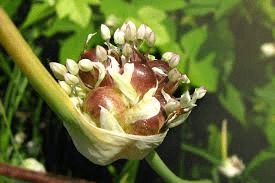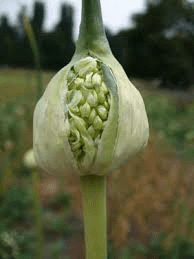One of the unique structures associated with garlic is the garlic bulbil, also known as a bulbil or bulbils. These small, bulb-like structures are often found growing at the top of garlic scapes, the long, slender flower stalks that emerge from the garlic plant. While garlic is typically propagated through cloves, bulbils serve as an alternative method of reproduction in certain garlic varieties.
Each garlic bulbil is essentially a miniature bulb that contains all the genetic material necessary to grow into a fully mature garlic plant. They are capable of producing new garlic plants without the need for pollination or fertilization, making them a form of asexual reproduction. This trait is advantageous for garlic plants growing in environments where pollinators may be scarce or where environmental conditions are not conducive to seed production.
Bulbils develop from the flowers of garlic plants after pollination occurs or sometimes even without pollination. They are initially small and green but gradually grow larger and mature over time. As they mature, bulbils may change in color, turning brown or even black. At this stage, they become detached from the garlic scape and fall to the ground, where they can take root and germinate under suitable conditions.
The process of bulbil germination is similar to that of garlic cloves. When planted in soil, bulbils send out roots and shoots, eventually developing into new garlic plants. However, compared to cloves, bulbils may take longer to mature into fully grown plants and produce bulbs. This delayed growth is due to the smaller size of bulbils and the energy required for them to establish root systems and develop into mature plants.
Despite their smaller size and slower growth rate, bulbils offer several advantages for garlic cultivation. They provide an additional method of propagation, allowing growers to expand their garlic crops without relying solely on cloves. Additionally, bulbils enable garlic plants to reproduce in diverse environments, including areas where traditional seed production may be challenging.
Bulbils also play a role in garlic breeding programs, as they can be used to introduce genetic diversity into garlic populations. Breeders can select bulbils from plants with desirable traits, such as disease resistance or unique flavors, and use them to develop new garlic varieties through selective breeding.
In conclusion, garlic bulbils are small, bulb-like structures that serve as a form of asexual reproduction in garlic plants. They develop from the flowers of garlic plants and contain all the genetic material necessary to grow into fully mature garlic plants.
While they may take longer to mature compared to cloves, bulbils offer advantages for garlic cultivation, including alternative propagation methods and increased genetic diversity. Understanding the biology of garlic bulbils is essential for garlic growers and breeders seeking to optimize garlic production and develop new varieties with desirable traits.
The Economic Importance and Uses of Garlic Bulbils

Garlic bulbils, often referred to as bulbils, are small structures found on garlic plants that serve as a means of asexual reproduction. Despite their diminutive size, garlic bulbils hold significant economic importance and have various uses in agriculture and beyond. Here are 18 economic importance and uses of garlic bulbils:
1. Alternative Propagation: Garlic bulbils provide an alternative method of propagating garlic plants, allowing growers to expand their garlic crops without relying solely on cloves.
2. Diverse Environments: Bulbils enable garlic plants to reproduce in diverse environments, including areas where traditional seed production may be challenging due to environmental factors or the absence of pollinators.
3. Genetic Diversity: Garlic bulbils contribute to genetic diversity in garlic populations, offering breeders a source of novel traits for developing new garlic varieties with improved characteristics.
4. Disease Resistance: Selecting bulbils from plants with desirable traits, such as disease resistance, can help breeders develop garlic varieties that are more resilient to pests and diseases, reducing the need for chemical interventions in agriculture.
5. Culinary Uses: While not commonly used directly in cooking, garlic bulbils can be processed into garlic powder or extracts for culinary applications, providing a unique flavor profile to dishes.
6. Medicinal Properties: Garlic bulbils contain similar health-promoting compounds as garlic cloves, such as allicin and antioxidants, making them a potential ingredient in herbal remedies and dietary supplements.
7. Cosmetic Products: Extracts derived from garlic bulbils may be used in cosmetic formulations for their purported antimicrobial and antioxidant properties, offering potential benefits for skincare products.
8. Botanical Research: Garlic bulbils serve as valuable research material for studying plant genetics, reproduction, and adaptation to different environmental conditions, contributing to advancements in agricultural science.
9. Soil Health: Introducing garlic bulbils into agricultural systems can improve soil health by promoting microbial activity and nutrient cycling, leading to increased soil fertility and productivity.
10. Livestock Feed: Garlic bulbils, when properly processed, can be incorporated into livestock feed formulations as a source of nutrients and bioactive compounds, potentially improving animal health and performance.
11. Herbal Remedies: In traditional medicine systems, garlic bulbils are sometimes used as a natural remedy for various health conditions, such as digestive disorders or respiratory infections.
12. Seed Production: Garlic bulbils are used in seed production for certain garlic varieties, providing a reliable source of planting material for farmers and ensuring consistent crop yields.
13. Culinary Experimentation: Chefs and food enthusiasts may experiment with garlic bulbils in culinary creations, exploring their unique flavor profiles and culinary applications in dishes.
14. Landscape Ornamentation: In ornamental gardening, garlic bulbils can be incorporated into garden designs for their decorative appeal, adding texture and visual interest to landscapes.
15. Educational Purposes: Garlic bulbils are used in educational programs to teach students about plant reproduction, propagation methods, and the importance of genetic diversity in agriculture.
16. Agroforestry Systems: Introducing garlic bulbils into agroforestry systems can enhance biodiversity and ecosystem services, such as pollination and pest control, contributing to sustainable land management practices.
17. Food Preservation: Garlic bulbils can be pickled or preserved in vinegar or oil, extending their shelf life and providing a flavorful addition to salads, marinades, and other dishes.
Read Also Scrapie in Sheep and Goats: Description, Damages Caused, Control and Preventive Measures
The Products and By-products That Can Be Derived From Garlic Bulbils

1. Garlic Powder: Bulbils can be dried and ground into garlic powder, a convenient culinary ingredient used in seasoning blends, sauces, and marinades.
2. Garlic Extracts: Extracts derived from garlic bulbils are used in the production of dietary supplements, herbal remedies, and natural health products for their potential medicinal properties.
3. Garlic Oil: Bulbils can be processed to extract garlic oil, which is used in cooking, aromatherapy, and natural health products for its characteristic aroma and potential health benefits.
4. Animal Feed: Garlic bulbils, when properly processed, can be incorporated into animal feed formulations to enhance palatability and provide nutritional benefits for livestock and poultry.
5. Soil Amendments: Residues from processed garlic bulbils can be used as organic fertilizers or soil amendments to improve soil fertility and structure, enhancing crop yields and plant health.
6. Botanical Extracts: Garlic bulbil extracts are used in cosmetic formulations for their purported antimicrobial, antioxidant, and skin-nourishing properties, appearing in skincare products such as creams, lotions, and serums.
7. Herbal Remedies: In traditional medicine systems, extracts derived from garlic bulbils are used as natural remedies for various health conditions, such as colds, flu, and digestive disorders.
8. Seed Banks: Garlic bulbils are stored in seed banks for conservation and future use in breeding programs, ensuring the preservation of genetic diversity in garlic populations.
9. Agrochemicals: Compounds extracted from garlic bulbils are used in the production of biopesticides and biofungicides, offering eco-friendly alternatives for pest and disease management in agriculture.
10. Culinary Additives: Garlic bulbil extracts are used as flavoring agents and natural preservatives in culinary applications, appearing in sauces, dressings, and condiments for their distinctive garlic flavor and aroma.
11. Medicinal Formulations: Extracts derived from garlic bulbils are used in the formulation of pharmaceutical products, such as tablets, capsules, and tinctures, for their potential health-promoting properties.
12. Herbal Teas: Dried garlic bulbils can be used to prepare herbal teas or infusions, consumed for their purported health benefits and immune-boosting properties.
13. Agricultural Biotechnology: Garlic bulbils serve as research material for studying plant genetics and biotechnology applications, such as genetic engineering and gene editing, for crop improvement and bioproduction.
14. Organic Pest Control: Garlic bulbil extracts are used as natural insecticides and repellents in organic farming, providing effective pest control solutions while minimizing environmental impact.
15. Fermented Foods: Garlic bulbils can be fermented and preserved in brine or vinegar to produce pickled garlic, a popular condiment and ingredient in various culinary traditions worldwide.
16. Herbal Infusions: Dried garlic bulbils can be infused in oil or vinegar to create flavored culinary ingredients, such as garlic-infused olive oil or garlic vinegar, used in salad dressings, marinades, and sauces.
Read Also Management of Breeding Stock in Sheep and Goats
Frequently Asked Questions (FAQ’s) About Garlic Bulbils

1. What are garlic bulbils?
Garlic bulbils are small structures found on garlic plants that serve as a means of asexual reproduction. They resemble miniature bulbs and contain all the genetic material necessary to grow into fully mature garlic plants.
2. How do garlic bulbils form?
Garlic bulbils develop from the flowers of garlic plants after pollination occurs or sometimes even without pollination. They grow at the top of garlic scapes, the long, slender flower stalks of garlic plants.
3. Are garlic bulbils edible?
While garlic bulbils are technically edible, they are not commonly consumed due to their small size and relatively intense flavor. However, they can be processed into garlic powder or extracts for culinary or medicinal purposes.
4. Can garlic bulbils be planted to grow garlic plants?
Yes, garlic bulbils can be planted in soil to grow new garlic plants. However, compared to cloves, bulbils may take longer to mature into fully grown plants and produce bulbs.
5. How long does it take for garlic bulbils to grow into mature plants?
The time it takes for garlic bulbils to grow into mature plants varies depending on environmental conditions, cultivar, and other factors. Generally, it may take one to two years for garlic bulbils to develop into fully mature plants capable of producing bulbs.
6. What are the advantages of using garlic bulbils for propagation?
Using garlic bulbils for propagation offers several advantages, including providing an alternative method of reproduction, enabling garlic plants to reproduce in diverse environments, and contributing to genetic diversity in garlic populations.
7. How do garlic bulbils contribute to genetic diversity in garlic populations?
Garlic bulbils contain genetic material that can introduce new traits and variations into garlic populations when used for propagation. This genetic diversity is essential for breeding programs aimed at developing new garlic varieties with improved characteristics.
8. Can garlic bulbils be stored for future use?
Yes, garlic bulbils can be stored in a cool, dry place for future use in propagation or breeding programs. Proper storage conditions help maintain their viability and genetic integrity over time.
9. Are there any special considerations when planting garlic bulbils?
When planting garlic bulbils, it’s essential to provide suitable growing conditions, including well-drained soil, adequate sunlight, and regular watering. Additionally, spacing and planting depth should be adjusted to accommodate the size of the bulbils and promote healthy growth.
10. Are there any risks associated with using garlic bulbils for propagation?
While garlic bulbils offer an alternative method of propagation, there are potential risks, such as variability in growth rates and bulb sizes, as well as susceptibility to environmental stressors. Careful selection and management of bulbils can help minimize these risks and optimize crop production.
Read Also How to Make an Avocado Tree Bear Fruit
